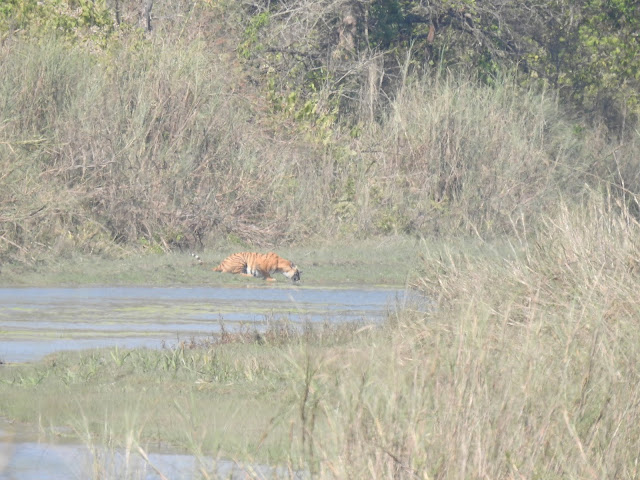Elephants of Bardia National Park
ASIATIC ELEPHANT (Elephas maximus)
Formerly migratory elephants moved between India and Bardia. Now, however, barriers to migration have separated the previously mixing herds. Elephants live up to seventy years and females produce a calf when they are twenty. The gestation period is 22 months, the longest of any living animal on the planet.
It is said that you can tell where an elephant comes from by looking at the size of his ears. African ears are like a map of Africa and Asian ears smaller like the shape of India. African ears are much bigger and reach up and over the neck, which does not occur in Asian elephants.
All African elephants, male and female, have tusks – whereas only some male Asian elephants have tusks. African tusks are generally bigger. About 50% of female Asian elephants and a small percentage of males have small tusk like teeth known as tushes.
We are currently in our low-season and are getting ready for the upcoming, high season, beginning in October. We are seeing elephants on a regular basis and have even had a herd of 42 feeding for more than an hour along the river bank close to our lodge. This is an exceptionally healthy number and is indicative of the success of the conservation measures implemented in Bardia National Park. If you would like to see an Asiatic Elephant then we are the perfect base to explore the park where you have a very high probability of connecting with the powerful, majestic species.
https://www.rhinolodgebardia.com/
 |
| A bull Asiatic Elephant, photographed recently, just 5 minutes from our lodge. |
Formerly migratory elephants moved between India and Bardia. Now, however, barriers to migration have separated the previously mixing herds. Elephants live up to seventy years and females produce a calf when they are twenty. The gestation period is 22 months, the longest of any living animal on the planet.
They have over 600 muscles in heir trunk and can weigh up to 3 tonnes. The huge bull elephant is one of the most impressive sights to be seen in Bardia.
There are several distinguishing features which separate the Asiatic Elephant from, it's close relative, the African Elephant, and here we will list some of the more prominent differences. The African elephant is significantly larger, with bulls growing up to 4m tall. The biggest Asian males reach no more than 3.5m. Adult African elephants weigh between 4,000-7,500kg. Asian males weigh between 3000-6,000kg.
African elephants have fuller, more rounded heads. The top of the head
is a single dome whereas Asian elephants have a twin-domed head with an
indent in the middle, rather like the humps on a camels back.
 |
| The diagnostic twin-domed skull shape of the Asiatic Elephant is clearly visible in this photo, also taken 5 minutes from the lodge |
It is said that you can tell where an elephant comes from by looking at the size of his ears. African ears are like a map of Africa and Asian ears smaller like the shape of India. African ears are much bigger and reach up and over the neck, which does not occur in Asian elephants.
 |
| A mother with two calves - here the small ear profile of the species can be clearly seen. |
All African elephants, male and female, have tusks – whereas only some male Asian elephants have tusks. African tusks are generally bigger. About 50% of female Asian elephants and a small percentage of males have small tusk like teeth known as tushes.
The trunk tip is a major difference between the species. The African
trunk has two distinct fingers which it uses to pick up and manipulate
objects. The Asian elephant has only one ‘finger’. The Asian compensates
for this by holding objects against the underside of the trunk and
appears not to suffer from any lack of maneuverability.
 |
| Asiatic Elephant on the left, with the significantly larger African Elephant to the right. |
We are currently in our low-season and are getting ready for the upcoming, high season, beginning in October. We are seeing elephants on a regular basis and have even had a herd of 42 feeding for more than an hour along the river bank close to our lodge. This is an exceptionally healthy number and is indicative of the success of the conservation measures implemented in Bardia National Park. If you would like to see an Asiatic Elephant then we are the perfect base to explore the park where you have a very high probability of connecting with the powerful, majestic species.
 |
| Part of the recent herd of 42 Asiatic Elephants seen near the lodge. |
Rhino
Lodge Bardia employs several highly experienced wildlife guides who can bring
you safely into the jungle and maximise your chances of seeing a wild elephant
with their deep understanding of field-craft, elephant behaviour and their
habitat preferences. Take a look at our website where you can find a whole
range of tours, to suit your needs, depending on how much time you have, what
other activities you would like to undertake and what other species you would
like to see:
https://www.rhinolodgebardia.com/



Comments
Post a Comment